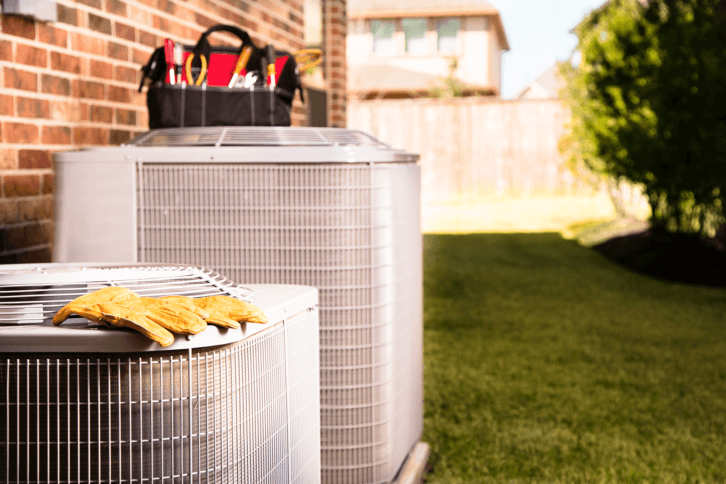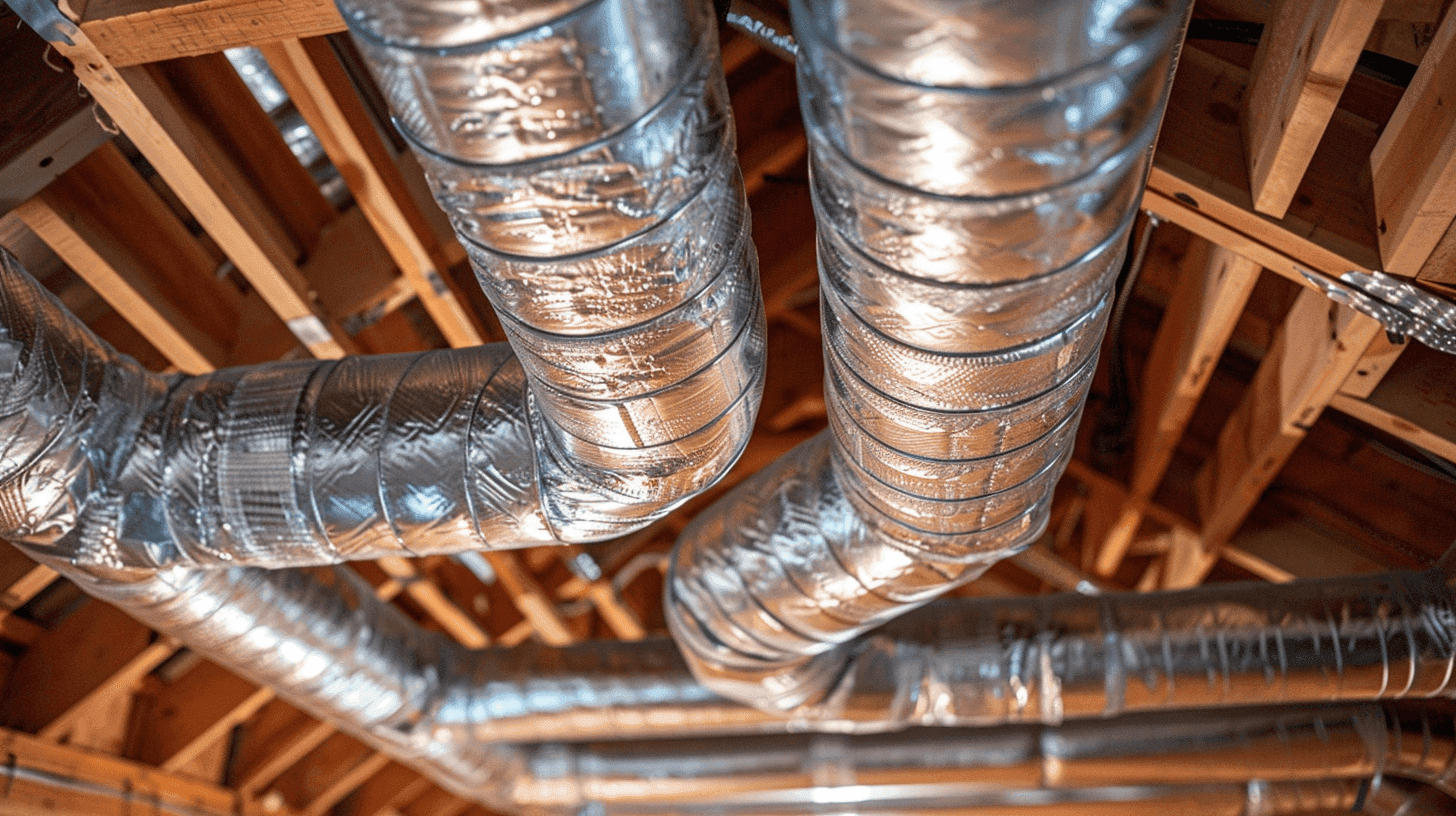
Goodman Air Handler Reviews
Sharing your quote takes less than a minute

If your home needs a boost of steady airflow, a new air handler could be a worthy investment. A Goodman air handler may save hundreds of dollars upfront, but is the value brand reliable enough to last?
This guide includes product reviews, brand comparisons, and more. Learn all you need to know about Goodman air handlers and whether they’re the right option for your home.
Intro to Goodman air handlers
An air handler is the indoor component of a split HVAC system. The air handler pairs with an outdoor heat pump or air conditioner to bring you even and consistent airflow.
A Goodman air handler unit consists of four parts: a blower motor, a fan, a filter, and an indoor coil. For a more detailed look at how air handlers work, check out our best air handlers of 2022.
Goodman makes traditional air handler units, wall-mounted air handlers, and ceiling-mounted air handlers. Goodman has some of the most affordable pricing on the market, with many models coming in hundreds of dollars cheaper than competitors.
Traditional air handler units are rectangular boxes that resemble lockers or safes. Wall-mounted units are shorter and wider than traditional units. Ceiling units are the smallest of all, so they’re great for discreet hanging.
The Goodman air handler lineup consists of four traditional unit series, two series of wall mount models, and one ceiling mount series. Going with a Goodman brings you unmatched flexibility in the placement and appearance of your air handler.
Are Goodman air handlers good?
Affordability is the name of the game with Goodman products. Below, we discuss some key features of Goodman air handlers and how they compare to other brands.
Coil technology
Goodman uses both aluminum-only and mixed-metal evaporator coils. Many of the traditional Goodman air handler models have all-aluminum evaporator coils.
Aluminum coils are less expensive than copper coils, but they are easy to replace and regularly in stock. Plus, the industry is moving toward aluminum-only coils as the standard.
The wall mount and ceiling mount models have aluminum tubing, but they use a different metal for the fins. Mixing metals may lead to faster corrosion. Other brands, like Trane air handlers, use all-aluminum coils in every model. If longevity is a priority for your air handler, opt for a Goodman unit from the AVPEC, AVPTC, or ASPT lines.
Warranty
The Goodman air handler warranty is standard for the industry but quite good for a value brand. As long as you register your air handler within 60 days of purchase, your unit is covered under a Registered Additional Term Warranty for 10 years.
The warranty language is fairly straightforward, explaining covered issues for all Goodman air handlers. Brands like Lennox offer 10-year warranty coverage for only premium models, so the Goodman warranty is an added value.
Blower motor speeds
Goodman offers permanent split capacitor (PSC) and electronically communicated motor (ECM) technology. PSC motors can run only at one speed, but ECM motors can run on low and high speeds to maximize energy efficiency.
The basic Goodman options use PSC motors, and the premium options use multi-speed or variable-speed ECM motors. Competing brands like Carrier and Lennox do not use PSC motors anymore, and even the basic options come standard with multi-speed ECM motors.
Many consumers prefer ECMs to PSCs because they run at a much lower volume. Plus, ECMs’ improved energy usage leads many consumers to lower electricity bills than with PSCs.
If it’s within your budget, we recommend going with an ECM whenever you can. While the use of PSCs helps Goodman be more affordable than competing brands, the motors are also lower quality and shorter-lasting.
ComfortBridge™ Technology
The two premium air handler series are compatible with Goodman’s proprietary ComfortBridge™ Technology. This feature acts like a self-regulating thermostat, adjusting your air handler settings to optimize your energy usage and keep your bills low.
While many competitors offer similar technology, there is a unique perk to ComfortBridge™. You can use ComfortBridge™ with any single-stage thermostat, so you don’t have to bundle other products to use the technology.
Many HVAC brands design their proprietary technology to work only with brand-specific items. For example, the Carrier Infinity™ line only works with Carrier smart thermostats and outdoor heat pumps.
A Goodman air handler will respond to almost any single-stage thermostat. If you already have a Google Nest or Ecobee that you love, Goodman won’t force you to give it up.
The ability to choose a Goodman air handler and not have to change your thermostat is a major benefit that could save you a couple hundred dollars. Goodman makes it easy to mix and match with other brands, but you’ll want to ensure the HVAC brand you have at home allows the same.
Air handler sizes
Every Goodman air handler is available in multiple sizes. Air handler sizing is usually measured in tonnage.
Tonnage does not refer to the weight of the air handler itself. Tonnage is the capacity output of the air handler unit.
Sometimes, air handlers are sized by British Thermal Units rather than tons. 12,000 BTU/hour is equivalent to 1 ton of output.
Goodman air handlers range from 1.5 to 5 tons of output. Your local Goodman dealer can help you determine what size air handler you need. While the air handler size must match your outdoor unit, it’s best to have your HVAC pro complete a Manual J calculation of your home to ensure you’re buying the right size system.
Goodman air handler prices
Goodman makes four series of single-family air handler units. The AVPEC and AVPTC could be considered premium options. The ASPT is a mid-level option, and the ARUF is the most basic air handler unit series.
The AWUF/AWUT series includes all wall mount models. The ACNF series contains all the ceiling mount models. Goodman air handler prices fluctuate based on size, your location, and your chosen dealer.
| Series | Motor Speed | Capacity | Cost (unit) | Dimensions (h X w X d) |
|---|---|---|---|---|
| AVPEC | Variable (ECM) | 1.5-5 | $785-$1,800 | 45” X 17.5” X 21” |
| AVPTC | Variable (ECM) | 2-5 | $785-$1,800 | 45” X 17.5” X 21” |
| ASPT | Multi-speed (ECM) | 1.5-5 | $730-$1,165 | 45” X 17.5” X 21” |
| ARUF | PSC | 1.5-5 | $595-935 | 45” X 17.5” X 21” |
| AWUF/AWUT | PSC/Multi-speed ECM | 1.5-3 | $435-685 | 36” X 20 ¼” X 16 ¼” |
| ACNF | PSC/Multi-speed ECM | 1.5-2.5 | $415-620 | 10” X 37 1/25” X 21” |
AVPTC and AVPEC
The AVPTC and AVPEC series include the most premium, feature-rich Goodman air handlers. Every model in these series comes with a variable-speed motor.
If you’re interested in zoning or setting different temperature and humidity levels in different areas of your home, these series make a great pick. Here’s what you get exclusively with the AVPTC and AVPEC series.
ASPT and ARUF
The basic Goodman units are more budget-friendly than many competing options. One perk of these models is the SmartFrame design, which insulates the blower and keeps your home from getting noisy while your air handler runs.
The ASPT Series has a more advanced ECM motor, which can lead to higher energy ratings. The ARUF Series uses a less efficient PSC motor, so the air handlers are less advanced but more affordable than ASPT.
AWUF/AWUT
Goodman groups the AWUF and AWUT air handlers into one series of wall mount models. These air handlers are built for small applications like closets.
Some models in each series use standard PSC motors, while others use efficient ECM motors, Energy efficiency can be hit-or-miss with this series depending on the motor you choose.
ACNF
The Goodman ACNF series includes ceiling mounted models. This series is built for small applications with a discreet, flexible design.
This air handler has a standard PSC motor, so energy efficiency won’t be stellar. However, the multi-position build makes for easy installation and service.
Goodman air handlers vs. competitors
Goodman has a reputation for making affordable, no-frills systems. Here, we break down some of the main takeaways of going with a Goodman.
Pros
- Wall and ceiling mount options
- Components and systems are accessible and inexpensive
- Compatible with third-party smart thermostats
Cons
- Louder, less efficient motors in many models
- Fewer tech features than competing brands
- Must register air handler for warranty
Goodman air handlers vs. Lennox
Goodman is one of the least expensive brands on the market, whereas Lennox has a reputation for high prices. Lennox air handlers can be as much as a thousand dollars more expensive.
Goodman air handler parts are generic, so they’re easier to find and less expensive. Lennox uses proprietary parts that are more expensive and regularly go out of stock.
Still, Lennox air handlers get much better energy efficiency ratings than anything Goodman can offer.
If your top priority is energy efficiency or comfort, go with a Lennox. However, Goodman products are significantly more affordable.
Goodman air handlers vs. Carrier
Goodman and Carrier both use a mix of aluminum and copper materials in their evaporator coils. However, Carrier air handlers are more energy efficient and generally last consumers longer.
One major component goes in Goodman’s favor: price. The entry-level Carrier models start about $500 higher than Goodman air handlers.
We recommend Carrier if you’re debating between both brands. Still, Goodman offers some of the most competitive pricing in the industry.
Goodman air handlers vs. Rheem
Goodman and Rheem use similar evaporator coils, as both mix copper and aluminum. However, Goodman has more air handler models with aluminum-only coils, and this is the trend the industry is moving toward.
Also, both companies still sell both PSC and ECM motors. Competing brands are shifting away from PSC motors, but both Goodman and Rheem use them in many models.
As with many brands, one key difference is price. Goodman air handlers come in at hundreds of dollars less than Rheem models, for comparable energy efficiency ratings.
Goodman is a popular value brand that delivers industry-low prices. While Goodman air handlers are not the most energy efficient available, many models are made with durable and long-lasting components.
A Goodman air handler is a great value option backed by a solid warranty. The air handlers may not be ultra-quiet or tech-savvy, but they get the job done for less.
Goodman air handler units
Goodman has an impressive catalog of value to mid-range air handlers. Choose from a variety of options, from traditional air handlers to wall and ceiling mounts.
Dive into every Goodman air handler available now. Learn how each series differs and decide which model is right for your home.
AVPEC Series
The AVPTC series includes the most premium, feature-rich Goodman air handlers. Every model in these series comes with a variable-speed motor.
ComfortBridge™ Technology keeps you informed on how your machine uses energy. If you’re looking for smart technology that won’t break the bank, this series is a great match. The AVPEC series comes in at hundreds cheaper than brands like Trane or Lennox.
Plus, the fan-only operation is great for saving money in the summertime. If you’re in a warm climate, we’d recommend an AVPEC air handler.
Note that this series is compatible with heating or cooling systems with an electronic expansion valve (EEV). If your system uses a thermal expansion valve, go for the AVPTC series.
AVPTC Series
Like the AVPEC, the AVPTC is one of the two most advanced Goodman air handler series. These air handlers have premium features like a variable-speed motor.
You get many of the same perks and features available on the AVPEC, like improved humidity and temperature control with ComfortBridge™ technology.
There’s one key difference between the AVPEC and AVPTC series. While the AVPEC series uses an electronic expansion valve (EEV), the AVPTC uses an internal thermal expansion valve (TXV).
Because of this difference, the AVPTC series is compatible with products that use an inverter. This means that you can pair this air handler series with air conditioners with variable cooling speeds.
If you have a variable-speed AC that you’re happy with, consider an AVPTC air handler. You’ll get impressive energy efficiency for hundreds less than competing premium options.
ASPT Series
The ASPT is a mid-range option from Goodman, just a step above the ARUF Series. The AVPTC and AVPEC series have more advanced technological features, but the ARUF has a less sophisticated motor.
Every model in the ASPT series has a multi-speed ECM blower. With this welcome upgrade, you may notice lower electricity bills and a more peaceful operating sound.
Plus, you can easily integrate it with your pre-existing heating or cooling system. An electronic expansion valve makes this air handler compatible with heat pumps and air conditioners.
We love the value of the ASPT series, as you get a durable cabinet and an impressive motor for the price. It’s a major upgrade from the basic ARUF series without a dramatic jump in price.
ARUF Series
The basic Goodman units are more budget-friendly than many competing options. One perk of these models is the SmartFrame design, which insulates the blower and keeps your home from getting noisy while your air handler runs.
The ARUF series is also easy for contractors to service, with an included coil mounting track. For the price, you’re also getting a more customized heating or cooling experience than competing brands offer. This series mounts vertically or horizontally, so you can place it up high or down low.
While there is partial foil insulation to keep condensation down, a more complete insulation would keep noise levels under better control. Competing brands like Carrier offer fully insulated cabinets, which we would recommend if you’re sensitive to noise levels.
Plus, the ARUF series only uses PSC motors. While you’ll save money up-front with this option, your ears would likely be happier with a less noisy motor.
AWUF/AWUT Series
Goodman groups the AWUF and AWUT air handlers into one series of wall mount models. The AWUF series comes with a check flow rater, while the AWUT series uses a more sophisticated thermal expansion valve (TXV).
The wall mount series includes a mix of ECM and PSC motors. While the wide variety will please an indecisive shopper, we suggest avoiding PSC motors when you can.
The evaporator coils use a mix of metals, which can lead to quicker corrosion. While the AWUF/AWUT series makes a great budget option, premium brands tend to use higher quality and longer-lasting components.
ACNF Series
The ACNF series includes all ceiling mount air handlers from Goodman. Many competing brands don’t even offer ceiling mounts, so we appreciate Goodman’s attention to variety and creating something for every consumer.
The ACNF series hangs up and away on the ceiling. The air handler won’t take up valuable space in your home, measuring just over three feet wide.
Many competing brands limit their ceiling and wall mounts to apartment buildings, so we like the unique flexibility for single-family homes.
Plus, all the ACNF models work with ductless return systems. If you’re in the market for a ductless system or live in an apartment, this series is a perfect fit.
Goodman air handler installation: what to expect
When you get a Goodman air handler installed, most HVAC contractors should have an easy time with the parts. The parts are generic, so they tend to be inexpensive and most contractors should have them in stock.
We suggest avoiding a DIY installation and having a contractor come by. Improper installation can damage your system and void the warranty, plus it may violate your local electrical code.
According to Angi, you will likely pay between $1,200 and $1,800 for the installation. Factors like zip code, climate, and air handler size all contribute to the final cost.
If you’re replacing your whole heating or cooling system, ask your contractor to do an ACCA Manual J calculation before you buy an outdoor unit. This metric will make sure you’re getting the right size outdoor unit to match your air handler.
Available Goodman air handlers
As with many brands, the more advanced models have better technology and special features. Here, we break down exactly what features are available with each model.
Keep in mind that some features are not available in every model in the series. We note where this applies.
All Goodman air handlers
Goodman air handlers may not have industry standard durability. Still, you’d be remiss to overlook the value brand entirely.
Here’s a look at the features that come standard with every Goodman air handler. Even the wall mount and ceiling mount options are included in the generous warranty.
- Tool-free filter access
- Horizontal or vertical configuration
- Galvanized finish
- 10-year parts warranty (if registered within 90 days)
ASPT and ARUF
The ARUF is the most basic option, with a standard PSC motor. The ASPT takes it a step above, using a more advanced ECM motor. Below are some features that the ceiling and wall mounted series lack.
- All-aluminum coils
- Coil mounting track
- SmartFrame design
- ECM blower motor (ASPT only)
AVPTC and AVPEC
If you’re interested in zoning, or setting different temperature and humidity levels in different areas of your home, the AVPTC and AVPEC series make a great pick. Here’s what you get exclusively with these advanced series.
- Variable-speed ECM motors
- ComfortBridge™ technology compatibility
- Fan-only setting
Goodman air handlers offer a wide variety that’s sure to please many homeowners. The options start in the value range, with the advanced options offering variable-speed motors and smart tech.
For homeowners seeking a budget-friendly option, any Goodman air handler series is a great choice. For proper sizing and installation of your air handler, reach out to your local Goodman dealer.
Sharing your quote takes less than a minute




